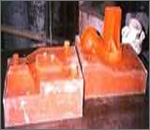Tooling costs for conventional die castings are such as to rule out their consideration unless very high production can be expected. As a thoroughly reliable optional methods, in which

no dies are required, we have developed a service which provides management with a means of proving out its new product, through the use of a simulated die casting (i.e. a precision casting comparable to a die casting, without the use of die cast dies.)
The precision plaster composition mold process produces any desired amount of uniform high-quality castings-indistinguishable, except for the vast difference in price, from first-class die-cast parts. The process is basically the plaster mold process.
However, it has been refined to incorporate a rubber pattern. The use of a rubber pattern, provides many advantages not found in conventional pattern equipment. Rubber patterns provide a much finer surface finish, since no parting agent is required.
Also, the rubber pattern permits the use of no draft, and in certain cases, back drafted conditions can be molded, thus eliminating the use of off-set parting lines and cores. The use of rubber patterns also allows a large quantity of parts to be produced with consistent accuracy.
This is not possible when using a conventional wood pattern, since most patterns made a wood, when subjected to the moisture of the plaster slurry, will lose dimensional stability. Through the use of rubber patterns, almost any type of original model can be used, such as wood, metal, plaster, clay, fiberglass, etc.


